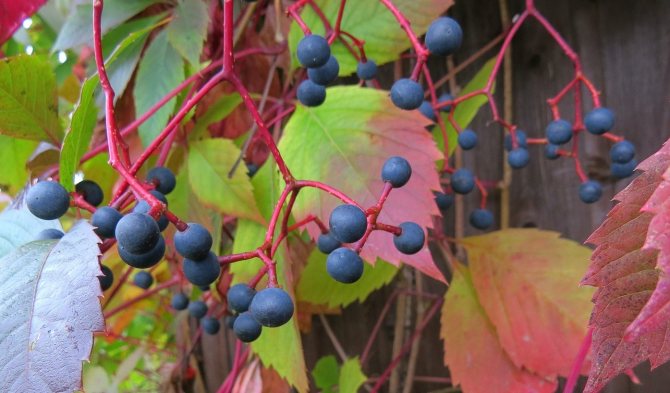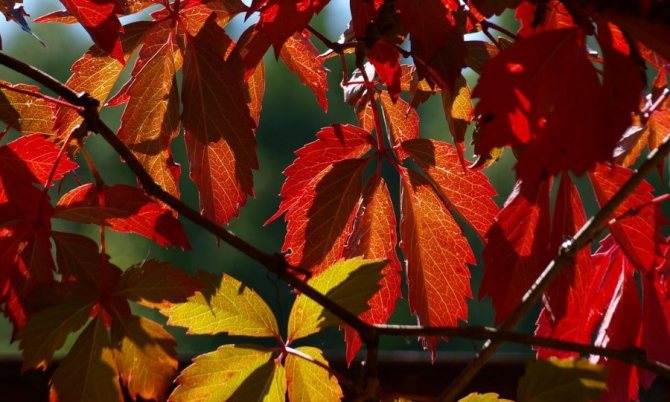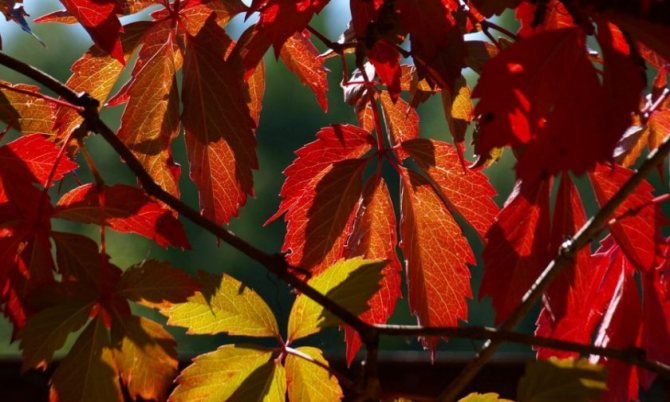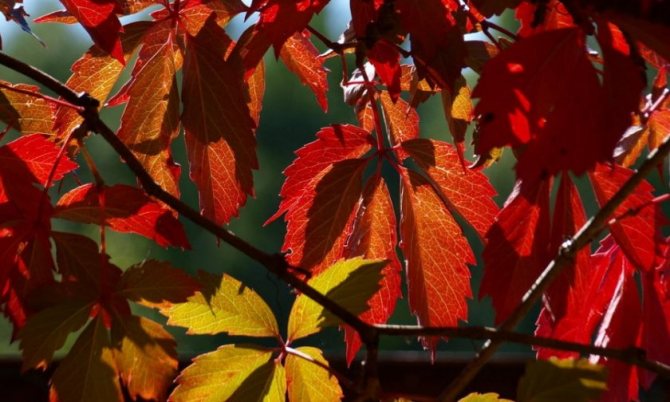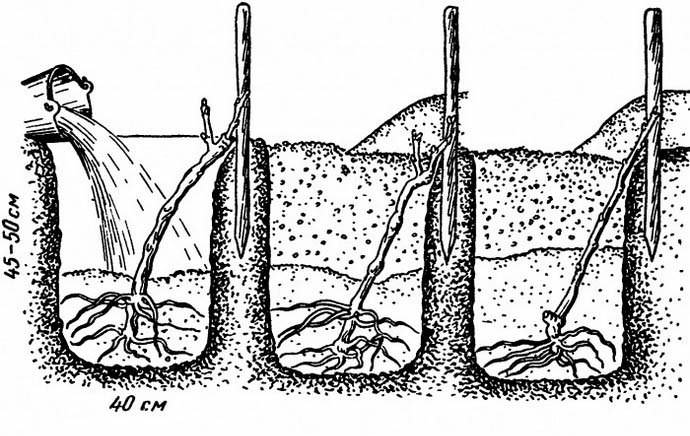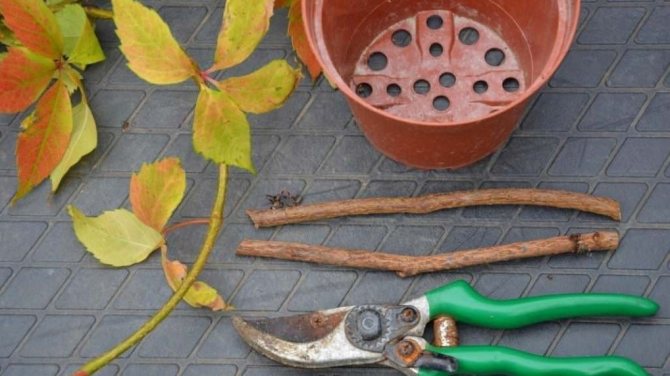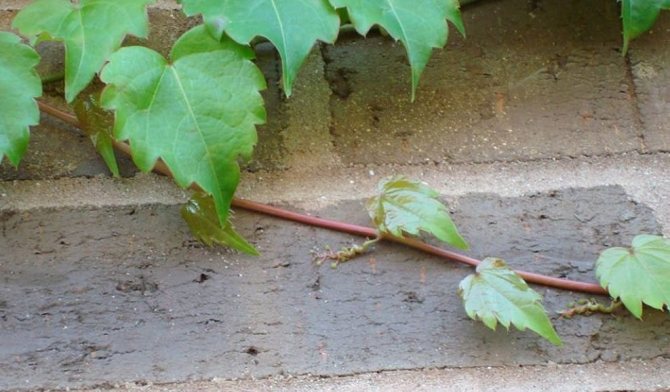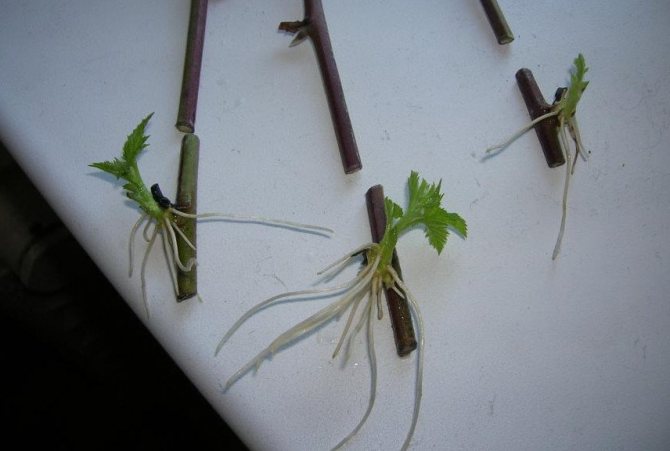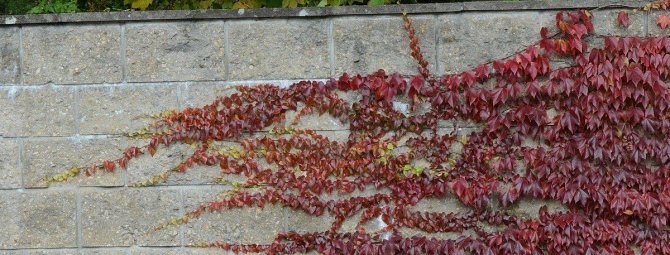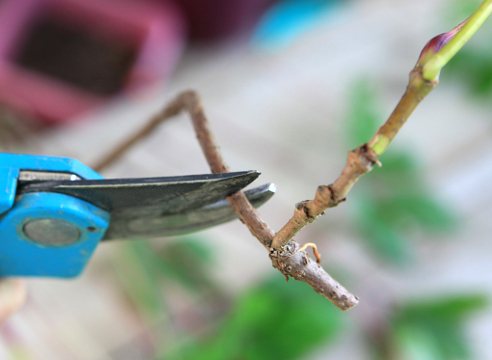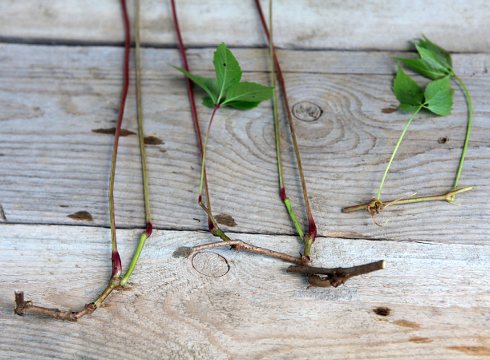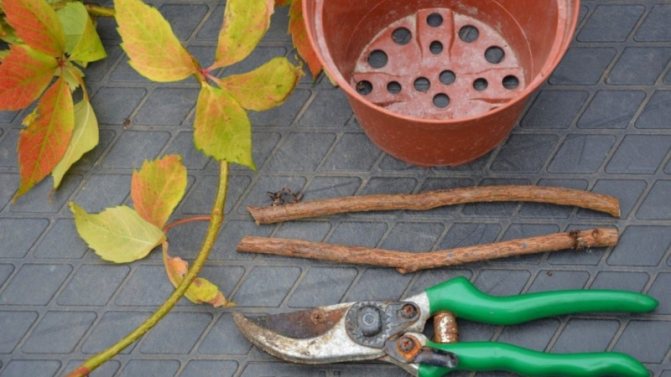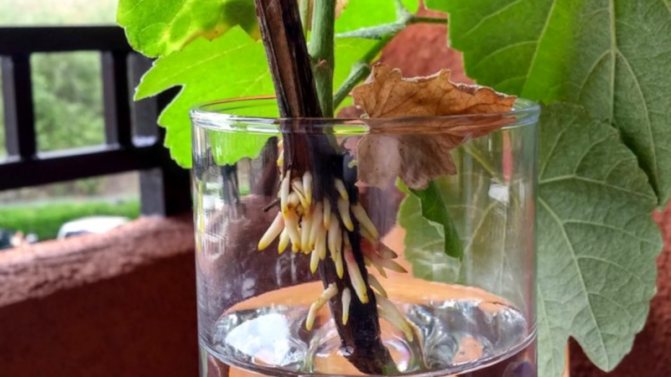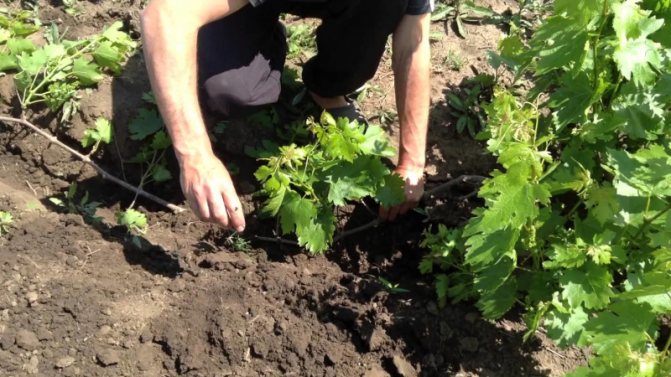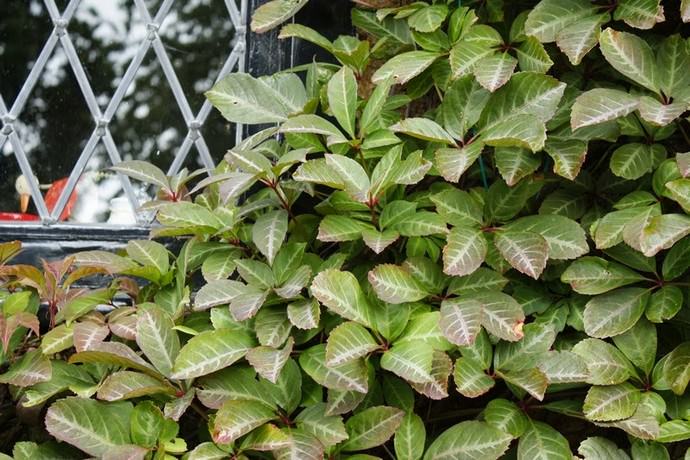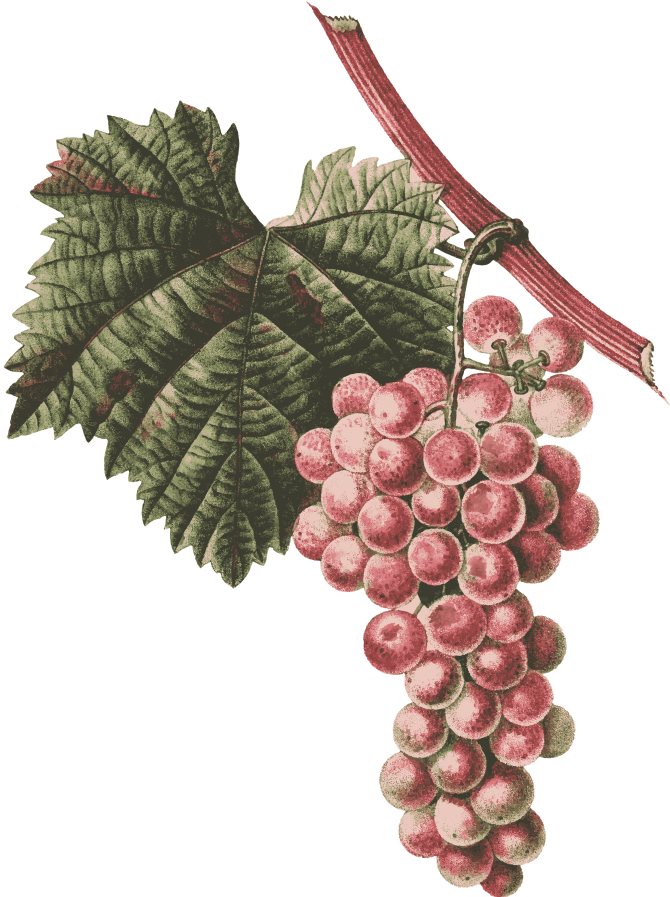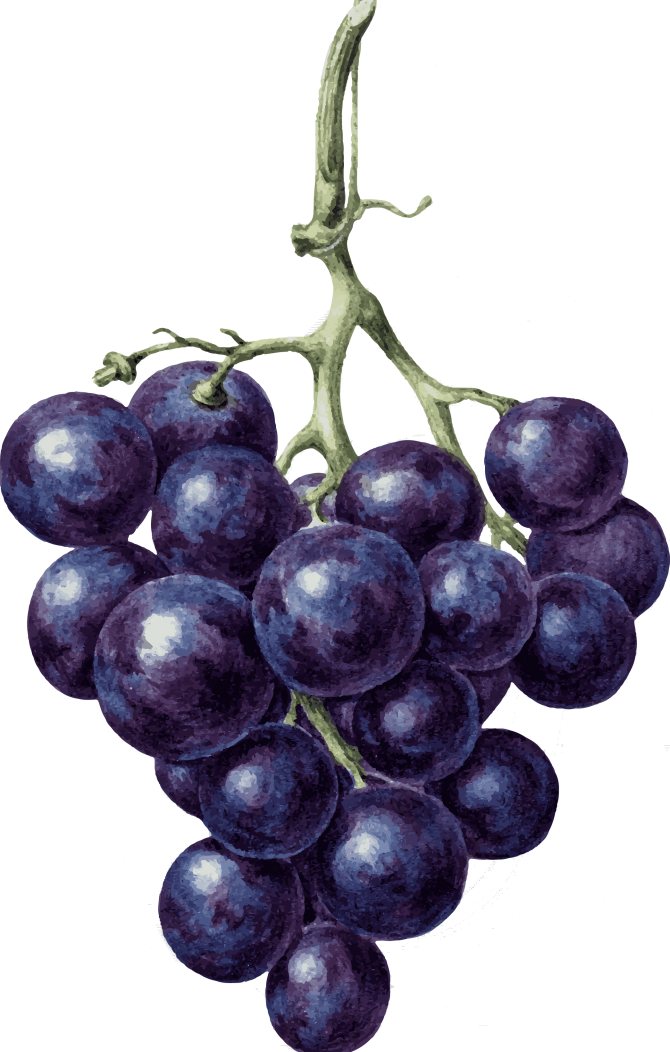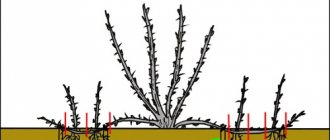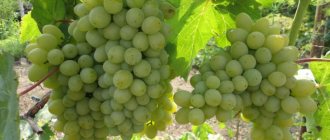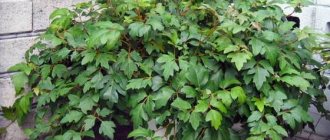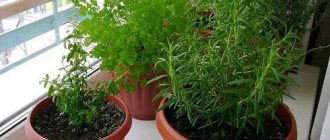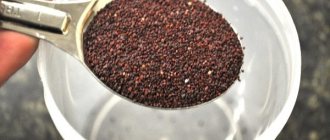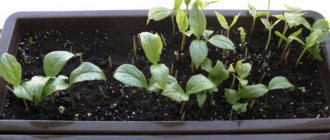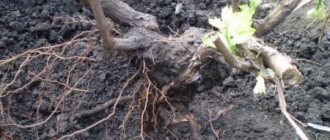Define characteristics
|
|
The fruits of wild grapes are small, have a tart-sour taste and are not used for food. They are used to prepare vinegar, medicinal decoctions, and wine tinctures.
Advantages:
- Fast growth (1.5–4 m per season).
- Unpretentiousness to the ground and lighting.
- Resistance to pests and diseases.
- Does not freeze in severe winters.
- Does not need additional feeding.
- Reproduces easily.
- It is a natural protection from wind, dust, precipitation.
- Creates a scenic look
Disadvantages:
- In confined spaces, a shaping haircut is required (4–5 times per summer).
- The need for the construction of supports.
- Without control, it can rapidly seize neighboring territories.
- Powerful roots go far to the sides and oppress adjacent plantings.
- Unsightly view in spring. Buds open slowly - until the end of May it stands with bare stems.
- Liana growing on the facade can penetrate under the roof and destroy it
Care
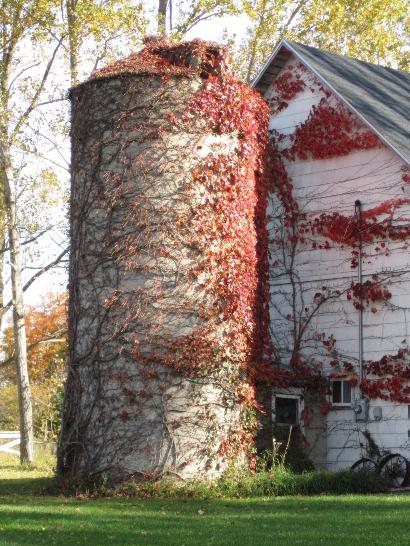

How to propagate girlish grapes and how to plant them correctly, now you know. It's time to talk about plant care.
After planting, the seedling grows rather slowly, since at first the plant spends all its energy on the formation of the root system. But upon reaching the age of three, the vine adds an average of 3 meters per season. Shoots of maiden grapes have tendrils, with the help of which they are held on any surface. Young plants do not have such, therefore they need support and tying.
In the first years after planting, special attention is paid to the formation of the skeleton of the plant, so that it visually takes on the required shape. Pruning will also help guide the growing vine in the direction you want it to be. How can I do that? With the help of a garden pruner, at about a meter height, the main shoot is trimmed. In this case, the side shoots are given the necessary direction by tying them up until they are completely lignified.
After the formation of the vine is completed, sanitary pruning is carried out annually - the removal of weak or damaged shoots. It is also necessary to cut out excess shoots, which only interfere with the high-quality growth of the crown.
Given the very fast growth rate of the plant, pruning should not be skipped. Otherwise, a very dense weave of shoots is obtained, which can be brought into a decent look only by the method of complete pruning.
Know the types of maiden grapes
Of the 10 varieties of wild grapes, two grow in our country: ivy (triangular) and virgin (five-leaf).
- Ivy or triangular... Bears great resemblance to ivy. Able to grow vertically and horizontally, like groundcover.According to the color of the foliage, it is divided into 3 varieties: Vicha / orange grapes; purple; golden. Ivy varieties are leading in terms of growth rate. The stem grows by 3-4 m per year.
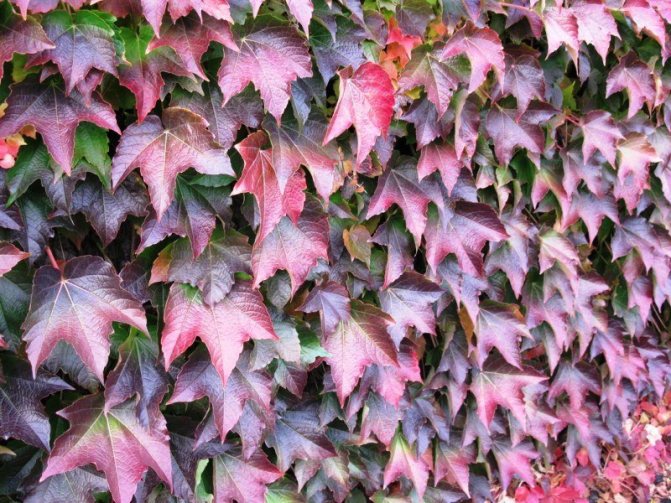

Ivy variety. Photo:
- Five-leafed or Virginian... It belongs to the most unpretentious species. Oblong leaves are located on long petioles (10–20 cm). Stems can grow up to 15 m, the annual growth is 200-300 cm. It grows anywhere, but it can be more beautiful and fast growing in shady places.
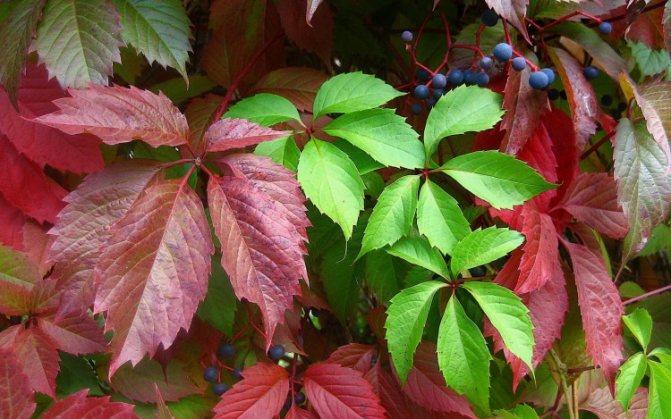

The virginian leaf consists of five separate plates attached to the petiole. Photo: ogorod-To give the desired shape, wild grapes need to be cut regularly, guided, tied up the stems, block growth, remove excess shoots.
Pros and cons of the plant
Probably the most important positive feature of the plant is the almost complete absence of any pests on the vine. Diseases also bypass it, so chemical treatments are not required.


The plant is very flexible and can take any desired shape. It is for this that it is valued most in landscape design. In our country, its huge popularity is explained quite simply - maiden grapes perfectly endure even severe frosts. And if other decorative vines simply freeze out, then girlish grapes grow only more actively after a harsh winter. In addition, the plant is so unpretentious that it will feel great anywhere.
Previously, many believed that the thickets of wild grapes, entwining the walls of the building, cause irreparable damage to them. But this turned out to be a mistake, since time has shown the opposite - vines serve as an excellent natural protection of walls from the effects of wind, rain and snow. In addition, they hide structural defects.
The plant has only one minus - too rapid growth and the need for frequent formative pruning. But this is such a small thing compared to the pleasure that you will experience from relaxing in the shade of its foliage.
To be able to reproduce correctly: 3 ways
There are three ways to breed wild grapes: cuttings, offspring, layering. All of them are simple and do not require any special skill. Subject to the rules, survival rate is 100%. The time of the events does not matter - Partenocissus is quite tenacious. You can propagate from spring to autumn, it is important to give it the opportunity to take root before frost.
- Cutting of maiden grapes
Growing from cuttings is considered the most productive method for producing a large number of new plants. Held in spring and summer. Propagation by cuttings has several tricks:
| Choosing a cutting in spring For reproduction, last year's woody shoot is taken. The pruner cuts off the entire lash or the part on which there is a knot. In the internode there is a thickening and antennae - the rudiments of the roots. The cut liana is divided into shanks-cuttings with 3-4 nodes |
| Choosing a cutting in summer A segment of last year's shoot with a young growth is used. Lateral processes (2-3 pieces) emerge from one kidney. This option gives a dense seedling - from which several shoots will begin to grow. The end of the stiff offspring should be at least 5 cm and have 1–2 root buds in the form of an outgrowth or tendril. The longer the cutting, the stronger the seedling. A 30 cm stalk will give a dense growth |
| Rooting in water Rooting takes place quickly in all conditions. For this, you can use a container with water. The leaves at the bottom of the twig are removed. The water should cover no more than 5 cm of the cutting. When transplanted into the ground, the water roots die off, permanent ones appear in their place. Adaptation is painless and quick |
| Rooting in the ground Parthenocissus gives excellent roots in the ground. If you have not decided on a place for planting, use seedling cups. It is advisable to choose a high container, at least 10 cm. Embed the short stalk by 5 cm, the long one (15–20 cm) - to the middle. Keep the soil moist, roots will appear in 8-10 days. Many rooted in a permanent place or in a strip-bed, where the seedlings can be left until the next season. |
I recommend immediately planting it in the ground. The water method is used if you do not have the opportunity to immediately plant in the ground.
- Layers
The most popular way to grow grapes vegetatively is by rooting cuttings. The method is simple and does not require any manipulation. Liana, upon contact with the ground, quickly gives roots.
The process can be accelerated by deepening or pressing. A strong whip is chosen, fits into an empty place, near the mother bush. It is pinned or lowered into a shallow groove (5 cm).
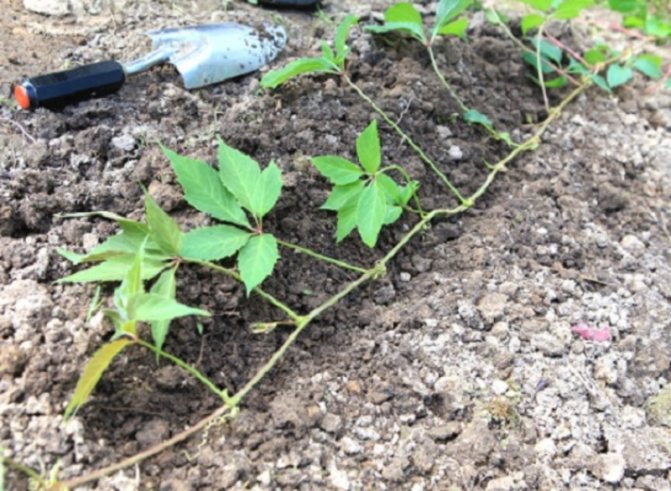

Try not to twist the stem or pull it away from the main trunk. Photo: nasotke.pro
Layers are not buried, the stem and leaves remain on the surface. In these places of internodes, strengthen the contact, put stones on the branch or use garden hairpins.
If the manipulation with the germination of cuttings was carried out at the beginning of June, then at the end of August the seedling is ready. Before planting in another place, cut off the shoot from the main branch with a pruner.
To obtain multiple plants, the long, rooted stem can be divided, leaving 1–2 internodes. Each part is dug out with a shovel, with a clod of earth.
Often the cuttings are left untouched until the next season. In this case, you will have powerful bushes that will quickly grow.
- Offspring
Parthenocissus forms shoots - root shoots, called offspring. In this case, you only need to dig out new bushes and plant in the right place.
The operation is carried out with a shovel in the summer (from May to August). The root offspring is cut off from the mother plant, with a clod of earth the seedling is transferred to a new place.


The offspring is a young plant with a strong root system, ready for transplantation. Photo: i1.
Features of cuttings
Cutting is done according to certain rules. To plant vines, you must first of all prepare the planting material. It is imperative that the plants are properly rooted so that they can actively grow and develop. In addition, you need to find the right time to perform all the manipulations.
Procurement terms
Cultivation of lianas with cuttings can be started in early spring and carried out before the onset of frost in the autumn. It is not at all necessary to wait until the buds wake up after winter and the leaves begin to unfold.
Some gardeners believe that the best period for cuttings is the first half of autumn. In the hot summer, the offshoots will need shelter from the rays of the sun and abundant watering. In spring, soil moisture deserves special attention. In addition, the vines will need to be protected from pests. In the autumn, such problems do not arise.
Root grapes
How to root grapes? The best soil for rooting is loose, breathable, fertile. Offspring and cuttings in it quickly form roots. The stem is deepened, reclining or at an angle - this will increase the volume of the root system. At least two buds remain above the surface.
The first 10 days you need to ensure regular watering - soil moisture affects the activation of root formation. It is advisable to immediately build a support: drive in guides or deepen iron pegs for tying lashes. After a month, your seedling will take root and give its first shoots.
Rooting in cups is carried out if it is not possible to plant it outside. It is better to root immediately in the open field.
What else do you need to know about breeding?
The possibility of growing your own planting material does not always exist.Having made the decision to plant maiden grapes on your site, you can buy seedlings in specialized nurseries or stores. When buying a container, it is important to make sure the plant is grafted. Liana in this case will take root much faster and begin to develop.
Container seedlings can be planted throughout the gardening season. Before you get the plant, thorough watering of the soil coma is required. When placing a plant in a planting pit, it is necessary to ensure that the root system fits freely there and is carefully straightened.
Plant wild grapes
When planting purchased or your own seedlings, planting dates should be observed. Plants grown in a container can be planted anytime through September. Rooted cuttings do not take root well in the July heat, but if watering is ensured, planting will be successful.
Better to plant in the fall, as it is already cool and the soil is moistened by rain. In the spring, such seedlings grow rapidly. In the Moscow region, the term lasts until mid-October. I offer step-by-step instructions.
- Seat selection
Liana's longevity suggests taking the choice of location seriously. You can plant on any site. In the sun, survival rate is worse, in active growth the bush will move only for 2-3 years. In a shady, semi-shady place, the plant will quickly take root and will give a large growth in the second year.
If you want to decorate a fence, gazebo, pergola, arch, take into account the volume of an adult plant. The thickness of the plane, with regular trimming, will be 50–70 cm. When planting near a building, you should step back 1 meter from the foundation and immediately put the guides.
- Landing
The interval between plants is maintained at 80–100 cm. If you want to get a dense mass of greenery in a short time, the distance is reduced to 50 cm. Having marked a place for holes, a 15–20 cm hole is dug into it, fertile soil (humus, compost) is poured into it.
When planting, deepen the root collar by 3-5 cm. Mulch the planting circle or cover it with peat, water it. For the first 3-4 days, make a sun screen or cover with a non-woven fabric. Keep the ground moist. In the first year, weed the planting site.
Choosing a landing site
Before you start breeding, you need to decide on its habitat in the future. Often, girlish grapes are used as a facade decoration.
In this case, there are several risk factors:
- destruction of the foundation by strong grape roots;
- suppression of nearby plants by a rapidly and aggressively developing root system;
- the possibility of lianas penetrating under the roofing material and violating its integrity;
- clogging of gutters with leaf litter.
It is better to plant grapes near pre-prepared supports around gazebos, along fences, above garden paths. It is imperative to make sure that the seedlings will not be exposed to direct sunlight. In a well-developed, high-quality and loose soil in conditions of shading, the plants will take root very quickly.
Look after
- In dry summers, watering is carried out 3-4 times per season. Water consumption: 10 l - per adult plant.
- For active growth, urea is introduced in the spring (2 tbsp. L. Per m²), in August - nitroammofoska or Kemira-Universal in the same amount.
- Dried branches are removed in the spring. In the summer, if necessary, a shaping haircut is carried out, with the removal of excess lateral processes. The frequency is selected individually, depending on the landing site and functionality.
- When slugs attack, insecticides are used.
Details about growing and caring for wild grapes - in the video:
Rules for preparing cuttings
Having decided to plant cuttings in the fall, they should be prepared from spring or summer using twigs with clearly visible leaves. You can prepare planting material from monochromatic shoots - they will be the healthiest.
Thick cuttings are not suitable for planting.Having cut off a suitable twig, it should be cleaned of the mustache and stepson's processes. Slices are made a couple of centimeters below the sheet.
The optimal length of the cutting is from twenty to thirty centimeters, it should have at least four formed buds.
Selection of cuttings
The material for the cultivation of maiden grapes can be prepared independently or purchased. When choosing grape seedlings, it is recommended to pay attention to their condition - there should be no mechanical damage on the cuttings.
It is best to acquire well-developed seedlings, without a lump of soil on the roots.


It is best to choose well-developed wild grape seedlings for purchase.

